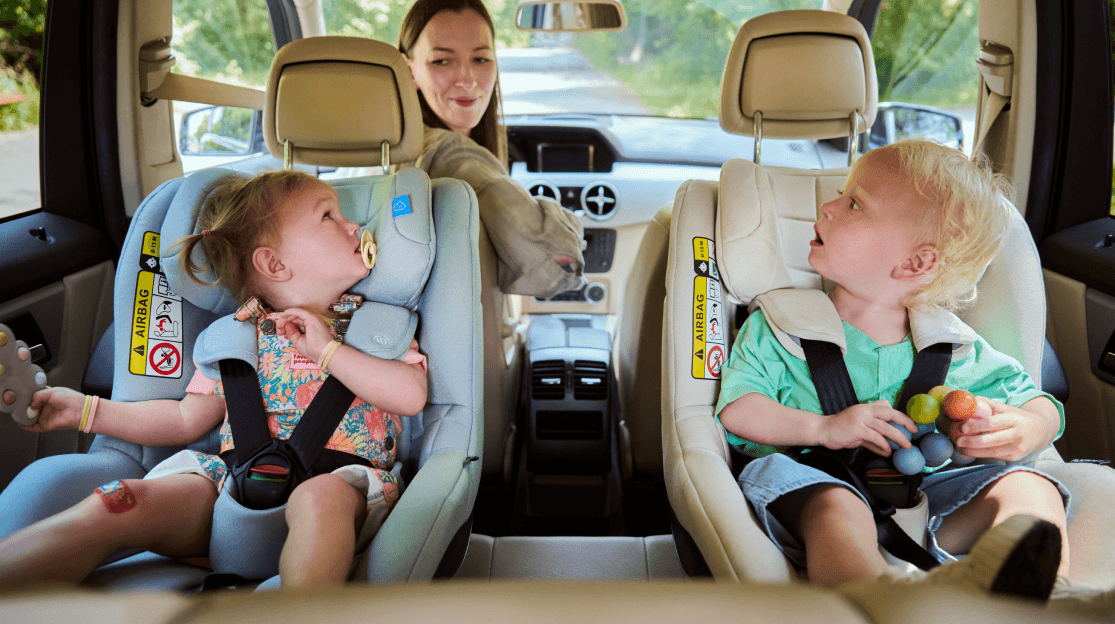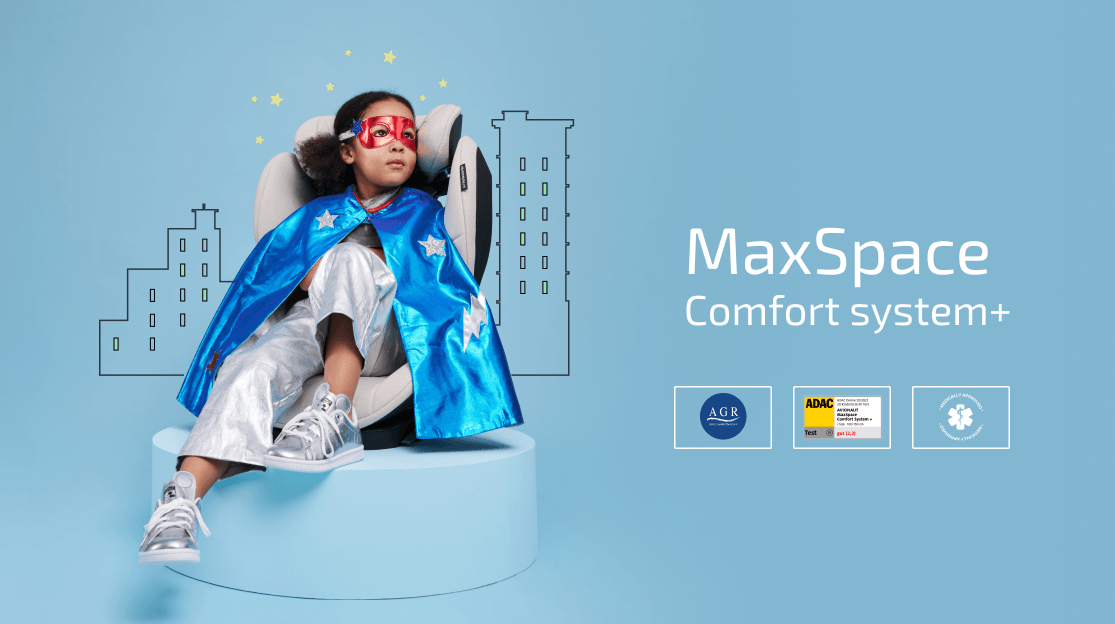
Strategies for a smooth ride: how to keep your child in a good mood while driving?
Is travelling by car with your child is a real nightmare for you, because as soon as you close the door and set off, the toddler starts an endless concerto of hysterical crying? Contrary to appearances, this is a problem that many parents face – not every child dozes peacefully through the entire journey, lulled into sleep by the noise of the buzzing engine. Today, we’re offering some ideas on how to calm your baby in the car. Get to know them and try them out. Who knows, maybe they will make your travels easier?

Contents:
- 1. How to calm your child in the car? First, find the cause of distress
- 2. Don’t lose patience
- 3. How to calm your child in the car? Check if they’re really comfortable
- 4. Start… singing
- 5. Have a playlist of children songs at the ready
- 6. Try to keep the child’s attention
- 7. Stick coloured stickers on the back of the rear seat
- 8. Have a lot of different toys at the ready
- 9. How to calm your child in the car? Be prepared for frequent stops
1. How to calm your child in the car? First, find the cause of distress
To find the answer to how to calm a child in the car, it is necessary to establish why the toddler reacts so hysterically to being transported in a car. In the case of infants, the reasons are basic ones: hunger, discomfort, wet diaper, too high or too low temperature, lack of a parent in the field of vision etc. Toddlers, who are already starting to crawl or walk, may be restless in the car for another reason: they would like to move around and continue exploring the world, but they have to sit in one place, strapped in. The reason for the whining of several-year-old children is most often that not, well, simple boredom. Motion sickness may also badly affect the child’s mood while driving.
The most difficult challenge is faced by parents whose child cries in the car because they simply do not want to sit in the seat. In other cases, in order to calm the child, it is sufficient to eliminate the ‘crying factor’.
2. Don’t lose patience
We realise that this is advice is one from the ‘easier said than done’ category, but there really is no other way – in the moments when our children throws its greatest tantrum, only peace can save us. Children are extremely sensitive to a tense atmosphere and any sign of nervousness only exacerbates their stress. So when you set off on your journey and the toddler starts their usual scene, use all your strength to not to get upset. Your irritation will only make things worse.
3. How to calm your child in the car? Check if they’re really comfortable
What do you do if you are uncomfortable while driving? You are bound to start squirming, looking for a more comfortable position, and when you fail to find one, you express your dissatisfaction out loud. This is a normal reaction. In the case of a child who is not yet able to verbally communicate their needs, a normal reaction is to cry. So if your toddler starts crying barely moments after being in the seat, make sure they are comfortable. Above all, check that the straps are correctly tightened and inspect the position of your child. In the summer, install special covers on the windows in the rear door – perhaps the reason for the discomfort is that the sun dazzles the baby. Also ensure that the temperature in the car is right (in the summer, air the car before the journey!) and that your child’s clothing is comfortable, airy, and skin-friendly.
The comfort of the toddler while driving is hugely influenced by the seat. Unfortunately, cheap, ‘supermarket’ seats do not have much to offer. In terms of safety, they also leave a lot to be desired, so we strongly advise against such purchases. A high-quality seat not only ensures the correct position of the child, which translates into comfort, but is also equipped with many comfort-boosting features. Our Pixel PRO 2.0 C, for example, has modular inserts that allow the seat to be adapted perfectly to the child’s body, a ventilation system, pleasant-to-touch, airy upholstery or a canopy to protect from the sun. For the greatest possible riding comfort, we have also prepared a seat for older children: MaxSpace Comfort System +. Its ergonomic design, complete with neck support, contoured lumbar support and deep seat means that the child’s spine gets extra support during the ride, what translates into greater comfort.
4. Start… singing
When your baby starts crying in the car, simply start… singing. Surely you know that in terms of calming toddlers, music can do real wonders, as exemplified by the lullabies, which make it easier to fall asleep. This method can also help while traveling. Don’t worry if you can’t hit the right note – a child is unlikely to realise. The idea is to focus their attention.
5. Have a playlist of children songs at the ready
If singing helps to soothe your child but is difficult for you to keep up because it takes your attention away from the road (or your throat is slowly refusing to cooperate), try turning on a playlist of children’s songs in the car.
6. Try to keep the child’s attention
If your child travels in a rear-facing seat, be sure to fit a special mirror on the headrest of the rear seat to observe your child. This way, you can check if the baby is all right in one glance. While driving, try to keep your child’s attention by talking to them – for example, about what is happening on the road or what you will be doing when you get there. You can also tell stories by changing your voice for a better effect.
7. Stick coloured stickers on the back of the rear seat
Sticking colourful stickers on the backrest of the rear seat is also an ingenious way to keep your child’s attention while driving. Any hanging toys that rotate and reflect light will also work well. But beware: while driving, safety is a priority, so make sure that these types of things do not compromise safety of the child.
8. Have a lot of different toys at the ready
In general, a parent or guardian should not sit in the car next to the child. This is because during a violent traffic incident a guardian may inadvertently hit the baby with their hand or, if they are leaning over the baby, also with their head, what is much worse. However, the situation in which a child reacts nervously to riding in a car is an exception. Being able to see their mom, dad, grandma or another close person can have a soothing effect on the child. It’s also a good idea to have a set of different toys on hand: colourful illustrated books, rattles, teddy bears – anything to occupy the little passenger’s attention.
For older children, all kinds of ‘car games’ also work well. You don’t need any accessories for them – all you need is creativity! You can play association games with your child, making up stories or looking for certain things, such as tractors, in the changing landscapes outside the window.
9. How to calm your child in the car? Be prepared for frequent stops
When travelling with children, it is a good idea to set yourself up for frequent stops. It is best to implement them in carefully selected places, for example with a playground or a lot of greenery and walking area, and not at a random gas station by the motorway. Children who are already walking on their own should have space to run, so they will be calmer on the road.
Calming a bored or impatient child in the car requires large amounts of patience and creativity. It is therefore advisable to prepare well for the journey: plan stops in preselected places that are attractive to a child, organise games, and bring toys or music.
If you are looking for more advice on how to prepare for a long car journey with your child, visit our Knowledge Base.





